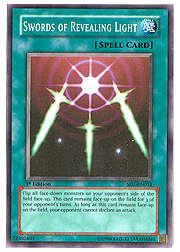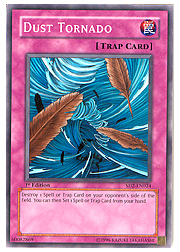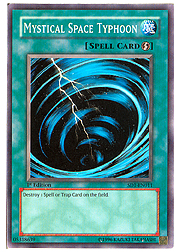Everything in the Yu-Gi-Oh! TCG comes back to the battle phase. Successful attacks will ultimately win you more games than anything else. This means that you will want to maximize your success on the battlefield. With that in mind, let’s take a look at what prevents a player from successfully gaining advantage through battle.
The first (and most important) thing to consider is the effects of the monsters you destroy in battle. We’ve looked into flip effects, self-replacing monsters, and instantaneous effect monsters that automatically pay for themselves. These are a player’s primary defenses against losing cards to attacking monsters. The second line of defense is a good offense. A defensive monster accompanied by a bigger monster will likely not be attacked for fear of a counter-attack.
For example, if I have Cyber Dragon in face-up attack position and a Blade Knight in face-down defense position, my opponent is not likely to summon Kycoo the Ghost Destroyer to attack my face-down monster. This is a very risky play, which I wouldn’t recommend for any player, unless he or she thinks the opponent can reduce his or her life points to 0 next turn. In this example, all the opponent needs is Snatch Steal or Brain Control and Zaborg the Thunder Monarch to completely turn around an otherwise equal game.
 The final lines of defense are a player’s spell and trap cards, and defensive cards are the defining aspects of today’s metagame. Cards like Sakuretsu Armor, Enemy Controller and Swords of Revealing Light can often prevent players from having any successful attacks. To provide a counter-balance to these overbearing defensive cards, the Yu-Gi-Oh! TCG introduced cards that destroy set spells and traps before the battle phase. Some of them have become powerhouse staples, such as Breaker the Magical Warrior, Heavy Storm and Mystical Space Typhoon. Mobius the Frost Monarch and Dust Tornado are also very strong, and very basic answers to face-down defensive cards.
The final lines of defense are a player’s spell and trap cards, and defensive cards are the defining aspects of today’s metagame. Cards like Sakuretsu Armor, Enemy Controller and Swords of Revealing Light can often prevent players from having any successful attacks. To provide a counter-balance to these overbearing defensive cards, the Yu-Gi-Oh! TCG introduced cards that destroy set spells and traps before the battle phase. Some of them have become powerhouse staples, such as Breaker the Magical Warrior, Heavy Storm and Mystical Space Typhoon. Mobius the Frost Monarch and Dust Tornado are also very strong, and very basic answers to face-down defensive cards.
The End Phase
Somewhere, someone realized that responding to the start of the end phase of the opponent’s turn would allow him or her to use Mystical Space Typhoon to destroy a trap card before it could be activated. Factor in the fact that your opponent cannot set another trap card because he or she has declared the end of his or her turn (and it’s not possible to set a new trap during the end phase), and that a new trick to nullify the trap threat has been laid on the table, and you’ve got a recipe for gaining advantage.
Sadly, the end phase trick is the most misused of all Yu-Gi-Oh! TCG tactics. Back in the Traditional format, players would rightfully destroy anything they could in the end phase. This was an acceptable strategy because there were so many chainable traps. Waboku was tier one, Time Seal had just begun seeing play, and Call of the Haunted could almost always grab Sangan, Witch of the Black Forest, or Jinzo. For the purposes of this article, we’ll call those cards “chainable.”
Fast-forward to today. Chainable cards are at an all-time low. The rule change that occurred just under a year ago stopped Book of Moon and Enemy Controller from being chainable on any monster that wasn’t summoned that turn or whose battle phase had yet to be changed. These two are also easy to play around. Simply wait to summon or change battle position until after you’ve activated your Mystical Space Typhoon. Time Seal has been outright forbidden, Jar of Greed and Reckless Greed are too slow for the metagame, Scapegoat has been restricted to one copy per deck, and most other chainable cards aren’t reliable enough to play.
With no chainable cards left, why are so many players activating their spell and trap destruction cards during the end phase of their opponent’s turn? For the most part, traps are no longer online as soon as the next turn starts. Many require specific triggers or have other requirements that make them unchainable to an effect that would destroy them. Let’s take a look at all the spells and traps from Shonen Jump Baltimore champion Shane Scurry’s decklist.
Spells: 11
2 Nobleman of Crossout
1 Brain Control
1 Book of Moon
1 Premature Burial
1 Smashing Ground
1 Graceful Charity
1 Heavy Storm
1 Confiscation
1 Mystical Space Typhoon
1 Snatch Steal
Traps: 9
1 Call of the Haunted
2 Return from the Different Dimension
1 Bottomless Trap Hole
1 Mirror Force
2 Dust Tornado
1 Sakuretsu Armor
1 Torrential Tribute
 Shane has five out of twenty cards that he could count on as chainable cards: Mystical Space Typhoon, Book of Moon, Call of the Haunted and two Dust Tornados. I’m not going to consider Return from the Different Dimension chainable, since it’s a win condition card, and usually wouldn’t be activated unless Shane was making his winning move (or some sort of ridiculously-needed tempo swing). Breaking down his chainable cards, we see that we can play around all of them.
Shane has five out of twenty cards that he could count on as chainable cards: Mystical Space Typhoon, Book of Moon, Call of the Haunted and two Dust Tornados. I’m not going to consider Return from the Different Dimension chainable, since it’s a win condition card, and usually wouldn’t be activated unless Shane was making his winning move (or some sort of ridiculously-needed tempo swing). Breaking down his chainable cards, we see that we can play around all of them.
If you have no spells or traps set, destroying Mystical Space Typhoon or both Dust Tornados can’t backfire. Playing around Book of Moon isn’t that difficult, as we learned earlier. Call of the Haunted can be tricky to play around, since Shane has two possible targets for its effect. The best way to play around Call is to wait until your opponent activates it, then chain. This can require a lot of patience. However, if you find that it was in fact Call of the Haunted that was face down, it will all be worth it.
Let’s Get Situational
Let’s say we have three Dust Tornados in our deck. What do we do with them when we draw them? The anti-climatic truth is that they should be used to pave the way to gain advantage in battle. By saving Dust Tornados until you have an excellent attack opportunity, you will be able to gain large swings in card presence at the time when they count most. In addition, by letting your Dust Tornados sit on the field, you’re ready for any Snatch Steal, Premature Burial, Call of the Haunted, or United We Stand that your opponent tries to throw your way. Let’s look at some really specific examples.
My opponent sets one face-down spell or trap and one monster. I draw, and among an average hand, I have Mystical Space Typhoon and Mystic Swordsman LV2. The correct play here is to use the Typhoon on my opponent’s defensive card and attack with Mystic Swordsman LV2. This allows you to strip your opponent of his or her two cards at the cost of one of your own. The Swordsman sits around as a floater (a monster that, if destroyed in battle, doesn’t lose advantage since the loss in battle is balanced by an advantageous effect they’ve already generated) and you’ve gained a little more control over the game.
My opponent sets two face-down spell or traps and one monster. I draw and once again have Mystical Space Typhoon, Mystic Swordsman LV2, and a handful of defensive cards. The correct play here is to set Mystical Space Typhoon and a defensive card. Whether or not I should summon the Swordsman to attack depends on the rest of my hand. If there are other monsters I deem more valuable, attacking with the Swordsman seems optimal. I can either force through my Swordsman’s effect, or accept a 1-for-1 trade with my least valuable monster.
I open the third game and set Dust Tornado and Dekoichi the Battlechanted Locomotive. My opponent opens by summoning Blade Knight and attacking my Dekoichi, then setting one spell or trap. Should I hit it with Dust Tornado in the end phase? It depends entirely on my hand. If I have Cyber Dragon, it would make sense to activate my Tornado. Doing so will allow me to swing Cyber Dragon into Blade Knight and even out the advantage I lost to it.
Suppose my next match begins the same way the third scenario just did, except I don’t have Cyber Dragon or any monster with more than 1600 ATK in my hand. Should I activate Dust Tornado in the end phase? There is no reason to. Doing it won’t hurt, as you’ll have a 1-for-1 trade and a chance to topdeck a monster to attack Blade Knight. However, the best play would be to conserve Dust Tornado until it becomes useful for something more than a 1-for-1 trade. Should you draw a monster big enough to take down Blade Knight, you can still activate Dust Tornado on your turn. Your opponent won’t likely have anything to chain at this point. Shane Scurry would only have Book of Moon on his own Blade Knight or Scapegoat. The Book does nothing but save his life points momentarily, but he likely wouldn’t activate it anyway, since I may be able to penetrate his low DEF, whereas I was unable to do so while the Knight was in attack mode.
Scapegoat is only chainable in the smallest sense of the term. In the current metagame, it isn’t easy to abuse, and the Sheep tokens often get destroyed in battle before they can do anything useful. As such, if you use Mystical Space Typhoon on your opponent’s copy of Scapegoat, then summon Sangan and destroy all four Sheep tokens within the next four turns, neither your nor your opponent has gained an advantage. Rather, you’ve just drawn four more turns’ worth of cards.
The last scenario happens to me in almost every tournament I enter. Say I open with a set Dust Tornado and Dekoichi the Battlechanted Locomotive. My opponent sets two spell or trap cards and a defense position monster. Next turn, I flip my Dekoichi and attack the face-down flip effect monster. It’s destroyed and its effect is used. I end my turn, and my opponent activates Mystical Space Typhoon in my end phase on my face down Dust Tornado. I then chain it and destroy one of his set cards, so that’s two cards destroyed for the cost of my one card.
 In this situation, there was no reason for my opponent to activate Mystical Space Typhoon. Dekoichi was a floater, and destroying it in battle would have merely offset the advantage I already gained from it. There was an additional risk that the card could be Book of Moon, to turn down my Dekoichi and reuse its effect. There was also no reason for me to use my Dust Tornado during the end phase of my opponent’s first turn. Destroying either one of the sets wouldn’t have helped me out. Rather, it would have been detrimental, since I couldn’t take advantage of my opponent’s misplay on my following turn.
In this situation, there was no reason for my opponent to activate Mystical Space Typhoon. Dekoichi was a floater, and destroying it in battle would have merely offset the advantage I already gained from it. There was an additional risk that the card could be Book of Moon, to turn down my Dekoichi and reuse its effect. There was also no reason for me to use my Dust Tornado during the end phase of my opponent’s first turn. Destroying either one of the sets wouldn’t have helped me out. Rather, it would have been detrimental, since I couldn’t take advantage of my opponent’s misplay on my following turn.
There are a few situations in which using spell and trap removal liberally will be beneficial. For example, if my opponent is playing Return from the Different Dimension, I will start hitting everything I can in the end phase as soon as I see enough removed monsters to scare me. There’s nothing worse than conserving a Dust Tornado that could have saved the game for you. Also, if you know your opponent is playing a lot of chainable burn cards, firing off as many end phase Dust Tornados as possible could save you.
The Lesson
I can’t stress the importance of your battle phase enough. Any cards that aid in the battle process by removing defensive spells or traps should be seriously considered. However, if you’re using a card for that purpose, make sure you use it for that purpose! Dust Tornado isn’t there to destroy spells and traps. It’s there to remove your opponent’s edge in battle. Hold your spell and trap removal cards until they can do what they’re intended to do, or you will find they don’t help you much at all.
Remember that this is a general rule for most decks and is subject to change. If your opponent plays a lot of chainable cards, the end phase becomes another tool for you to shut down your opponent’s traps. After game 1, you should have your mind set on whether or not you’ll play your spell and trap removal cards liberally or conservatively. Also remember that this rule could change as formats and metagames shift. Whenever you’re playing Dust Tornado, you should be asking yourself, “Will this help me generate advantage in battle?”
Email any feedback, questions or comments to mpeddle80@hotmail.com.